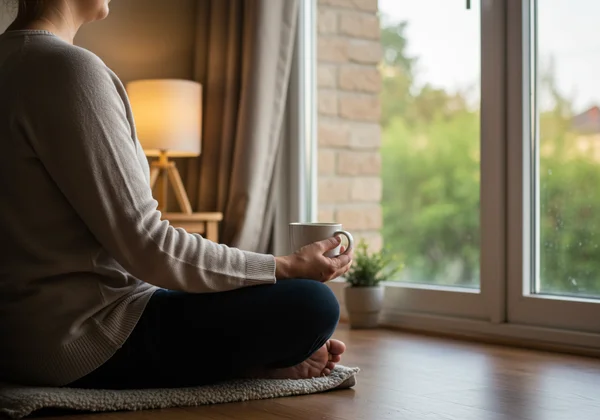Support Someone with Agoraphobia: A Guide for Family & Friends, Plus an Agoraphobia Test
Watching a loved one struggle with agoraphobia can feel overwhelming and isolating. You want to help, but you may not know where to start or what to say. This guide is here to offer empathetic, practical strategies for friends and family to support someone with agoraphobia effectively. How to live with someone who has agoraphobia? It begins with understanding, patience, and the right tools. We’ll empower you to become a positive force in their journey toward recovery, starting with the simple step of gaining clarity through a confidential online agoraphobia test.
Understanding Agoraphobia & Its Impact on Daily Life
Before you can offer meaningful help, it’s crucial to understand what your loved one is truly experiencing. Agoraphobia is more than just a dislike of crowds; it’s a complex anxiety disorder rooted in the fear of being in situations where escape might be difficult or help unavailable if panic-like symptoms arise. Acknowledging the depth of this challenge is the first step in providing genuine living with agoraphobia support.
What Agoraphobia Truly Feels Like: Beyond Just Being Housebound
A common misconception is that everyone with agoraphobia is completely housebound. While this can be true in severe cases, many individuals exist on an agoraphobia spectrum. They may be able to go to specific "safe" places, travel at certain times of the day, or venture out if accompanied by a trusted person like you. Can you be agoraphobic and still leave the house? Absolutely. The defining factor isn't just avoidance of places but the intense fear and anxiety associated with them. This fear can be paralyzing, even if they manage to push through it.
The Invisible Walls: How Fear Manifests in Everyday Situations
For someone with agoraphobia, the world is filled with invisible walls built from fear. Everyday situations that most people take for granted can become monumental challenges. The core fear often revolves around having a panic attack and feeling trapped, helpless, or embarrassed. Key signs of agoraphobia you might notice include a persistent fear of:
- Using public transportation (buses, trains, planes)
- Being in open spaces (parking lots, bridges)
- Being in enclosed spaces (shops, theaters)
- Standing in line or being in a crowd
- Being outside of the home alone
Their world can shrink significantly as they begin avoiding these triggers, which can impact their career, relationships, and overall quality of life. Understanding these triggers is key to providing effective support.

Practical Ways to Support Someone with Agoraphobia
Once you have a better understanding, you can begin offering practical help for agoraphobia. Your role is not to be their therapist but to be a patient, reliable, and compassionate ally. Your support can create a stable foundation from which they can begin their journey of recovery.
Communicating Effectively: What to Say (and What Not To Do)
The words you choose matter immensely. It's essential to validate their feelings without validating the fear itself. Avoid dismissive statements like "Just get over it" or "It's all in your head." This is one of the most important things to know about what not to do. Instead, practice active listening and empathetic communication.
What to Say:
- "I'm here for you, and we'll get through this together."
- "That sounds incredibly difficult. Thank you for telling me."
- "I can see you're scared, and that's okay. What can I do to help you feel safer?"
- "Let's take this one step at a time. What feels like the smallest possible step we could try today?"
What to Avoid:
- Forcing them into situations they're not ready for.
- Expressing frustration or disappointment with their progress.
- Making them feel guilty for how their condition affects you.
- Comparing their struggle to someone else's, e.g., "My cousin had anxiety and they just went out anyway."
Encouraging Small, Manageable Steps Towards Recovery
Recovery from agoraphobia often involves gradually and systematically facing feared situations, a technique central to many therapeutic approaches. While you are not their therapist, you can support this process. Encourage tiny, manageable steps that build confidence. This is a form of agoraphobia self help that you can facilitate. For instance, if leaving the house is the goal, start with just sitting on the front porch together for five minutes. Celebrate every small victory, no matter how insignificant it may seem. Progress is rarely linear; there will be good days and bad days. Your unwavering encouragement is what matters most. For more resources, you can explore our information.

Navigating Outings Together: Creating "Safe Zones"
When your loved one feels ready to attempt an outing, your support can make all the difference. The fear of leaving the house is immense, so planning is key. Work together to create a sense of safety. This could involve choosing a less crowded time to visit a store, parking near an exit, mapping out a route with quiet places to rest, or agreeing on a signal they can use if they feel overwhelmed and need to leave immediately. Your calm and reassuring presence acts as a "safe zone," making the challenge feel more approachable.

Encouraging Professional Help & Prioritizing Your Well-being
While your support is invaluable, it isn't a substitute for professional treatment. A crucial part of your role is to gently guide your loved one toward expert help while also taking care of your own mental health. This is a cornerstone of effective agoraphobia family support.
When & How to Gently Suggest Professional Support
Broaching the topic of therapy requires sensitivity. Wait for a calm moment to have the conversation. You can frame it as a sign of strength and a proactive step toward regaining control. Mention that there are many effective agoraphobia treatment options, like Cognitive Behavioral Therapy (CBT), which has a high success rate. Suggesting they take a confidential online self-assessment can be a non-threatening first step, helping them understand their symptoms in private before speaking to a professional.
Understanding Self-Care for Supporters: Why Your Well-being Matters Too
Supporting someone with a significant anxiety disorder can be emotionally draining. It's vital to recognize the importance of caregiver well-being. Prioritizing your own well-being is essential; you can't offer consistent care if you're depleted. Make time for your own hobbies and friendships, set healthy boundaries, and consider seeking support for yourself, whether through a support group or a therapist. Protecting your own mental health ensures you can continue to provide consistent and compassionate care for your loved one.

Empowering Your Loved One: A Journey of Patience, Understanding & Hope
Supporting someone through agoraphobia is a journey demanding patience, profound understanding, and unwavering belief in their path to recovery. By educating yourself, communicating with empathy, and encouraging small, brave steps, you can be an incredible source of hope and strength.
Remember, the first step is often understanding. Encourage your loved one to explore their feelings in a safe and private way. A great starting point is the free, scientifically-informed agoraphobia test available on our homepage. It takes just a few minutes and can provide the clarity needed to take the next step. Visit our homepage to learn more and support your loved one today.
Agoraphobia Support: Common Questions for Loved Ones
How do you support someone with agoraphobia effectively without enabling avoidance?
This is a delicate balance. The key is to validate their fear without reinforcing the avoidance. Instead of saying, "Okay, we just won't go out," try, "I understand going to the store feels impossible right now. How about we try just sitting in the car together for a few minutes?" This acknowledges their feeling while still encouraging a micro-step forward. It’s about being a partner in bravery, not an enabler of retreat.
What are the key signs to look for if I suspect a loved one has agoraphobia?
Look for a pattern of avoiding specific situations due to fear of panic or helplessness. This includes avoiding crowds, public transport, or leaving home alone. They may express intense anxiety when faced with these situations or go to great lengths to have a companion with them for "safe" outings. These are clear signs of agoraphobia developing.
Can a person with agoraphobia still lead a fulfilling life, and what does that look like?
Absolutely. With proper treatment and a strong support system, many people with agoraphobia learn to manage their anxiety and significantly expand their worlds. A fulfilling life might look different for everyone; it could mean being able to go to the grocery store without fear, traveling to see family, or simply enjoying a walk in a local park. Recovery is about reclaiming freedom and quality of life, not necessarily eliminating all anxiety forever.
How can I gently encourage my loved one to consider taking an agoraphobia screening test?
You can frame it as a low-pressure tool for self-discovery. Say something like, "I found this confidential online tool that helps people understand their anxiety better. It's not a diagnosis, but it might offer some insight into what you've been feeling. We could even look at it together if you'd like." Emphasizing that it's free, quick, and anonymous can lower the barrier to trying a free agoraphobia test.